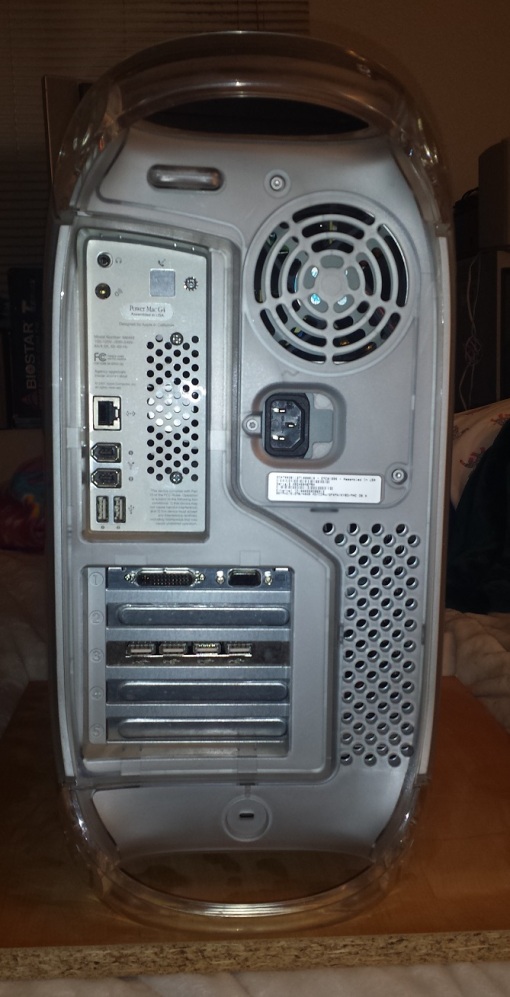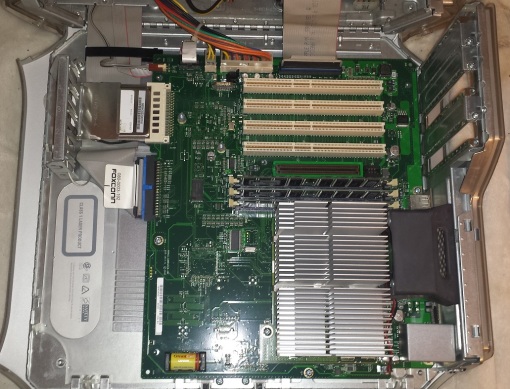The G4 Macintosh was produced between 1999 and 2004 in three main distinctive variations known sometimes as the “original G4’s” or “Sawtooth” models, the “Quicksilver” G4’s and the “Mirror Drive Door” or MDD G4’s. Even among these there were motherboard variations. For instance early models of the “original” line lacked an AGP slot. The G4 I’m going to talk about today is a sub model known as the “Digital Audio” G4 and falls somewhere between the original line and the Quicksilver models. Basically It has the motherboard of an early Quicksilver model in the case of the original line.
To be honest I’ve grown kind of fond of the G4 towers over time. They tend to strike a sort of balance between the good things about apple such as design and the Power PC CPU and a IBM compatible such as expandability and more standard ports and drives.
The case design for all the G4’s is more or less the same basic design with most of the variations concerning the color and style of the frontal bays. The digital audio G4 uses the same case as the Sawtooth line and is a pleasant white/bluish color. There are also these handle looking things that are on every corner which in all honestly are nice for assisting lifting and moving the relatively heavy tower. On the front we have two 5 1/4 bays.
Internal shot of the two bays.
one usually sports a DVD/CD drive as mine does and the other sometimes a 100mb ZIP drive depending on your model. Mine obviously lacks the ZIP drive but one can be added easily enough.
Also on the front we have a grill for the built in speaker as well as a power button that glows a nice white when powered on as well as a programmers button and a reset button beneath that. The programmers button can be used to bring up a console window for debugging and can also be used to update firmware.
Under the fan slot we have a standard power jack and to the left we have our built in ports. At the top we have a modem jack and two audio ports. The top jack is a standard headphone jack and below that is an apple speaker mini-jack for high fidelity apple speakers. Further down we have a Ethernet port followed by two Firewire 400 ports and a pair of USB 1.1 ports. Below that we have five slots for internal expansion cards. The top one is taken up by my video card since the G4 machintosh’s do not have built in video. further down I added a Firewire/USB card for more connectivity.
Unlike many of the earlier Mac’s I’ve reviewed here the G4 uses a seemingly higher quality plastic and a lot more metal so the case feels much more sturdy and less prone to “brittletosh” issues. Opening the case is getting inside is ridiculously easy and may be the easiest time I’ve ever had getting into any PC or Mac. All you do is lift the handle on the side of the case and….
Once open you have almost full and unimpeded access to the board. At first I thought the motherboard seemed very barren and unpopulated but many of the chips and capacitors are actually mounted on the underside of the board. There are also three spots on the bottom of the case for mounting hard drives. Currently I only have one lowly 40GB IDE drive mounted.
On to the motherboard.
1) CPU – The Digital Audio G4’s came with a variety of CPU speed options starting at 466mhz. Mine is the highest end model sporting a 733mhz PowerPC 7450 processor sometimes refered to as a G4e (enhanced) as it is a redesigned and improved version of the G4 CPU. Its very hard to find CPU comparisons between PPC and Intel x86 CPU’s on the web but I would wager its perhaps equivalent to a faster Pentium III. This motherboard is running on a 133mhz front side bus.
2) CMOS battery – Is the standard 3.6 V lithium battery to save settings. Like all Macs the death of these batteries tend to cause more issues then what I see happen in PC’s. If your having odd instabilities replace these things first.
3) RAM – Three slots for SDRAM supporting up to 1.5gb of PC133 RAM
4) Expansion slots – four 64 bit 33mhz PCI slots and one AGP x4 slot for a video card.
Video – The Digital Audio G4’s came with one of several video cards. Mine came with an AGP ATI Rage 128 Pro with 16 MB VRAM. Keep in mind that if your using a x8 AGP card whether a MAC card or a PC card that has been flashed with a mac BIOS you need to disable pins 3 & 11 to get video. This applies to all G4 Mac’s with the exception of the AGP 2x Sawtooth models. This issue is due to apple using the at the time unassigned pins for “ADC” apple monitors connection. When AGP x8 came out those pins were suddenly used for something else so basically they wouldn’t run on a G4 Macintosh. The way around this is to disable the pins completely either by taping over them or cutting the traces making the card a AGP x4.
This card is a Macintosh version so it comes with both a VGA port and an Apple Display Connector port. Its not really the most exciting card but it does well enough for 90’s games and some early 2000’s games. Your going to want to upgrade though for any series turn of the century gaming though. Officially the Digital Audio models were sold with up to Geforce 2 or 3 cards installed (some conflicting information).
5) Wireless airport card connector for well….connecting to wireless devices.
6) IDE connectors – Two ATA-66 connectors for connecting a total of four IDE devices. In my setup I have my DVD drive connected to the onboard ata66 connector but I’m using an ATA100 PCI card to connect to the hard drive.
7) ATX power connector.
I haven’t really done much to this machine since I got it. I’m currently running OS X 10.4.11 which is the highest officially supported version of the OS.
For comparison I also have a standard Macintosh Quicksiver G4. For all intents and purposes the Quicksiver is basicly identical to the Digital Audio except for the case and improved specs stock such as faster CPU and graphics cards.

I rather like the look of the front speaker without the grill.

On the read we have the same connections though my Quicksilver here lacks the modem. Finally a look at the motherboard which looks a little diffrent as far as some smaller compoents but has the same amount and placement of major compoents such as expansion slots.

I haven’t used this particular Mac much because I have a more powerful MDD G4 that I will eventually cover here that I use for present general early OS X stuff. That said I do like the Digital Audio G4. most of all I like the color scheme and ability to easily add a ZIP drive, even though I currently haven’t and probably will not.











2 Comments
Nice! These machines certainly look well built.
I’m pretty sure the PPC G4 is faster than the Pentium III CPU, but it’s not a straight forward comparison. The general rule of thumb I heard was about 1.5 times the clock speed is roughly equivalent. (about 1100Mhz here). At the time the x86 architecture was actually one of the slower ones running around with PPC, SPARC, and Alpha architectures all outperforming it by significant margins. It has become faster than everything else now, largely because they sell so well AMD and Intel have more money for R&D to improve them than anyone else.
Those ATI Rage cards are pretty decent, of course not great at 3d, but good for 2d graphics. They actually turn up regularly in server hardware as onboard graphics (or cards) because they are reliable and simple. I’ve also noted they turn up on many architectures, I know they also exist for Sun machines, The only real difference being the ROM.
Anyhow, nice to see the insides of one of these!
Sparcie
It is surprisingly rugged. Apple had a thing for ATI back in the late 90’s early 2000’s. It seems many of there machines had some sort og Rage card built in or installed.